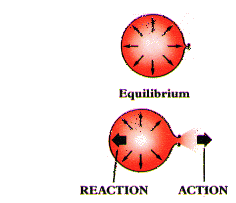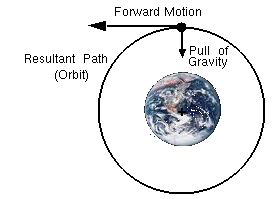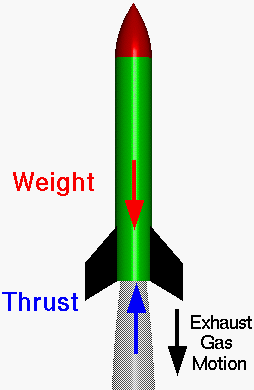|

|
|
Rocket Principles
A rocket in its simplest
form is a chamber enclosing a gas under pressure. A small opening at one
end of the chamber allows the gas to escape, and in doing so provides
a thrust that propels the rocket in the opposite direction. A good example
of this is a balloon. Air inside a balloon is compressed by the balloon's
rubber walls. The air pushes back so that the inward and outward pressing
forces are balanced. When the nozzle is released, air escapes through
it and the balloon is propelled in the opposite direction.
|
 |
When we think of
rockets, we rarely think of balloons. Instead, our attention is drawn
to the giant vehicles that carry satellites into orbit and spacecraft
to the Moon and planets. Nevertheless, there is a strong similarity between
the two. The only significant difference is the way the pressurized gas
is produced. With space rockets, the gas is produced by burning propellants
that can be solid or liquid in form or a combination of the two.
|
One of the interesting
facts about the historical development of rockets is that while rockets
and rocket-powered devices have been in use for more than two thousand
years, it has been only in the last three hundred years that rocket experimenters
have had a scientific basis for understanding how they work.
The science of rocketry
began with the publishing of a book in 1687 by the great English scientist
Sir Isaac Newton. His book, entitled Philosophiae Naturalis Principia
Mathematica, described physical principles in nature. Today, Newton's
work is usually just called the Principia. In the Principia, Newton stated
three important scientific principles that govern the motion of all objects,
whether on Earth or in space. Knowing these principles, now called Newton's
Laws of Motion, rocketeers have been able to construct the modern giant
rockets of the 20th century such as the Saturn V and the Space Shuttle.
Here now, in simple form, are Newton's Laws of Motion.
- Objects at rest
will stay at rest and objects in motion will stay in motion in a straight
line unless acted upon by an unbalanced force.
- Force is equal
to mass times acceleration.
- For every action
there is always an opposite and equal reaction.
As will be explained
shortly, all three laws are really simple statements of how things move.
But with them, precise determinations of rocket performance can be made.
Newton's
First Law
This law of motion is
just an obvious statement of fact, but to know what it means, it is necessary
to understand the terms rest, motion, and unbalanced force.
Rest and motion can be thought of as being opposite to each other. Rest
is the state of an object when it is not changing position in relation
to its surroundings. If you are sitting still in a chair, you can be said
to be at rest. This term, however, is relative. Your chair may actually
be one of many seats on a speeding airplane. The important thing to remember
here is that you are not moving in relation to your immediate surroundings.
If rest were defined as a total absence of motion, it would not exist
in nature. Even if you were sitting in your chair at home, you would still
be moving, because your chair is actually sitting on the surface of a
spinning planet that is orbiting a star. The star is moving through a
rotating galaxy that is, itself, moving through the universe. While sitting
"still," you are, in fact, traveling at a speed of hundreds of kilometers
per second.
Motion is also a
relative term. All matter in the universe is moving all the time, but
in the first law, motion here means changing position in relation to surroundings.
A ball is at rest if it is sitting on the ground. The ball is in motion
if it is rolling. A rolling ball changes its position in relation to its
surroundings. When you are sitting on a chair in an airplane, you are
at rest, but if you get up and walk down the aisle, you are in motion.
A rocket blasting off the launch pad changes from a state of rest to a
state of motion.
The third term important
to understanding this law is unbalanced force. If you hold a ball in your
hand and keep it still, the ball is at rest. All the time the ball is
held there though, it is being acted upon by forces. The force of gravity
is trying to pull the ball downward, while at the same time your hand
is pushing against the ball to hold it up. The forces acting on the ball
are balanced. Let the ball go, or move your hand upward, and the forces
become unbalanced. The ball then changes from a state of rest to a state
of motion.
In rocket flight,
forces become balanced and unbalanced all the time. A rocket on the launch
pad is balanced. The surface of the pad pushes the rocket up while gravity
tries to pull it down. As the engines are ignited, the thrust from the
rocket unbalances the forces, and the rocket travels upward. Later, when
the rocket runs out of fuel, it slows down, stops at the highest point
of its flight, then falls back to Earth.
|
 |
Objects in space
also react to forces. A spacecraft moving through the solar system is
in constant motion. The spacecraft will travel in a straight line if the
forces on it are in balance. This happens only when the spacecraft is
very far from any large gravity source such as Earth or the other planets
and their moons. If the spacecraft comes near a large body in space, the
gravity of that body will unbalance the forces and curve the path of the
spacecraft. This happens, in particular, when a satellite is sent by a
rocket on a path that is parallel to Earth's surface. If the rocket shoots
the spacecraft fast enough, the spacecraft will orbit Earth. As long as
another unbalanced force, such as friction with gas molecules in orbit
or the firing of a rocket engine in the opposite direction from its movement,
does not slow the spacecraft, it will orbit Earth forever.
|
Now that the three
major terms of this first law have been explained, it is possible to restate
this law. If an object, such as a rocket, is at rest, it takes an unbalanced
force to make it move. If the object is already moving, it takes an unbalanced
force, to stop it, change its direction from a straight line path, or
alter its speed.
Newton's Third
Law
For the time being,
we will skip the second law and go directly to the third. This law states
that every action has an equal and opposite reaction. If you have ever stepped
off a small boat that has not been properly tied to a pier, you will know
exactly what this law means.
|
 |
A rocket can lift off from a launch pad only when it expels gas out of
its engine. The rocket pushes on the gas, and the gas in turn pushes on
the rocket. The whole process is very similar to riding a skateboard.
Imagine that a skateboard and rider are in a state of rest (not moving).
The rider jumps off the skateboard. In the third law, the jumping is called
an action. The skateboard responds to that action by traveling some distance
in the opposite direction. The skateboard's opposite motion is called
a reaction. When the distance traveled by the rider and the skateboard
are compared, it would appear that the skateboard has had a much greater
reaction than the action of the rider. This is not the case. The reason
the skateboard has traveled farther is that it has less mass than the
rider. This concept will be better explained in a discussion of the second
law.
|
With rockets, the
action is the expelling of gas out of the engine. The reaction is the
movement of the rocket in the opposite direction. To enable a rocket to
lift off from the launch pad, the action, or thrust, from the engine must
be greater than the mass of the rocket. In space, however, even tiny thrusts
will cause the rocket to change direction.
One of the most
commonly asked questions about rockets is how they can work in space where
there is no air for them to push against. The answer to this question
comes from the third law. Imagine the skateboard again. On the ground,
the only part air plays in the motions of the rider and the skateboard
is to slow them down. Moving through the air causes friction, or as scientists
call it, drag. The surrounding air impedes the action-reaction.
As a result rockets
actually work better in space than they do in air. As the exhaust gas
leaves the rocket engine it must push away the surrounding air; this uses
up some of the energy of the rocket. In space, the exhaust gases can escape
freely.
Newton's Second
Law
This law of motion is
essentially a statement of a mathematical equation. The three parts of the
equation are mass (m), acceleration (a), and force (f). Using letters to
symbolize each part, the equation can be written as follows: f
= ma
By using simple algebra,
we can also write the equation two other ways: a
= f/m
m = f/a
The first version of
the equation is the one most commonly referred to when talking about Newton's
second law. It reads: force equals mass times acceleration. To explain this
law, we will use an old style cannon as an example.

When the cannon is fired, an explosion propels a cannon ball out the open
end of the barrel. It flies a kilometer or two to its target. At the same
time the cannon itself is pushed backward a meter or two. This is action
and reaction at work (third law). The force acting on the cannon and the
ball is the same. What happens to the cannon and the ball is determined
by the second law. Look at the two equations below.
f = m(cannon) *
a(cannon)
f = m(ball) * a(ball)
The first equation refers
to the cannon and the second to the cannon ball. In the first equation,
the mass is the cannon itself and the acceleration is the movement of the
cannon. In the second equation the mass is the cannon ball and the acceleration
is its movement. Because the force (exploding gun powder) is the same for
the two equations, the equations can be combined and rewritten below.
m(cannon) * a(cannon)
= m(ball) * a(ball)
In order to keep the
two sides of the equations equal, the accelerations vary with mass. In other
words, the cannon has a large mass and a small acceleration. The cannon
ball has a small mass and a large acceleration.
Let's
apply this principle to a rocket. Replace the mass of the cannon ball
with the mass of the gases being ejected out of the rocket engine. Replace
the mass of the cannon with the mass of the rocket moving in the other
direction. Force is the pressure created by the controlled explosion taking
place inside the rocket's engines. That pressure accelerates the gas one
way and the rocket the other.
Some interesting
things happen with rockets that don't happen with the cannon and ball
in this example. With the cannon and cannon ball, the thrust lasts for
just a moment. The thrust for the rocket continues as long as its engines
are firing. Furthermore, the mass of the rocket changes during flight.
Its mass is the sum of all its parts. Rocket parts includes engines, propellant
tanks, payload, control system, and propellants. By far, the largest part
of the rocket's mass is its propellants. But that amount constantly changes
as the engines fire. That means that the rocket's mass gets smaller during
flight. In order for the left side of our equation to remain in balance
with the right side, acceleration of the rocket has to increase as its
mass decreases. That is why a rocket starts off moving slowly and goes
faster and faster as it climbs into space.
Newton's second
law of motion is especiaily useful when designing efficient rockets. To
enable a rocket to climb into low Earth orbit, it is necessary to achieve
a speed, in excess of 28,000 km per hour. A speed of over 40,250 km per
hour, called escape velocity, enables a rocket to leave Earth and travel
out into deep space. Attaining space flight speeds requires the rocket
engine to achieve the greatest action force possible in the shortest time.
In other words, the engine must burn a large mass of fuel and push the
resulting gas out of the engine as rapidly as possible. Ways of doing
this will be described in the next chapter,
practical rocketry..
Newton's second
law of motion can be restated in the following way: the greater the mass
of rocket fuel burned, and the faster the gas produced can escape the
engine, the greater the thrust of the rocket.
Putting Newton's
Laws of Motion Together
An unbalanced force
must be exerted for a rocket to lift off from a launch pad or for a craft
in space to change speed or direction (first law). The amount of thrust
(force) produced by a rocket engine will be determined by the mass of
rocket fuel that is burned and how fast the gas escapes the rocket (second
law). The reaction, or motion, of the rocket is equal to and in the opposite
direction of the action, or thrust, from the engine (third law).
|
|
